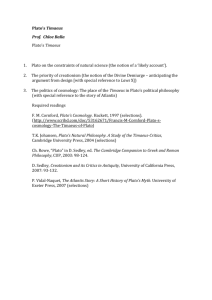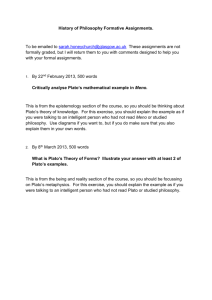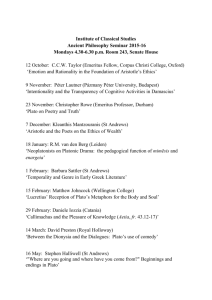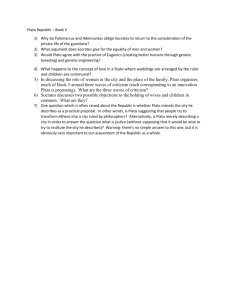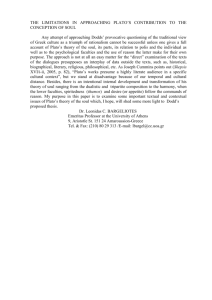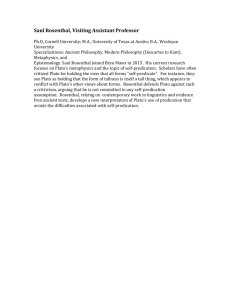Chapter 1
advertisement
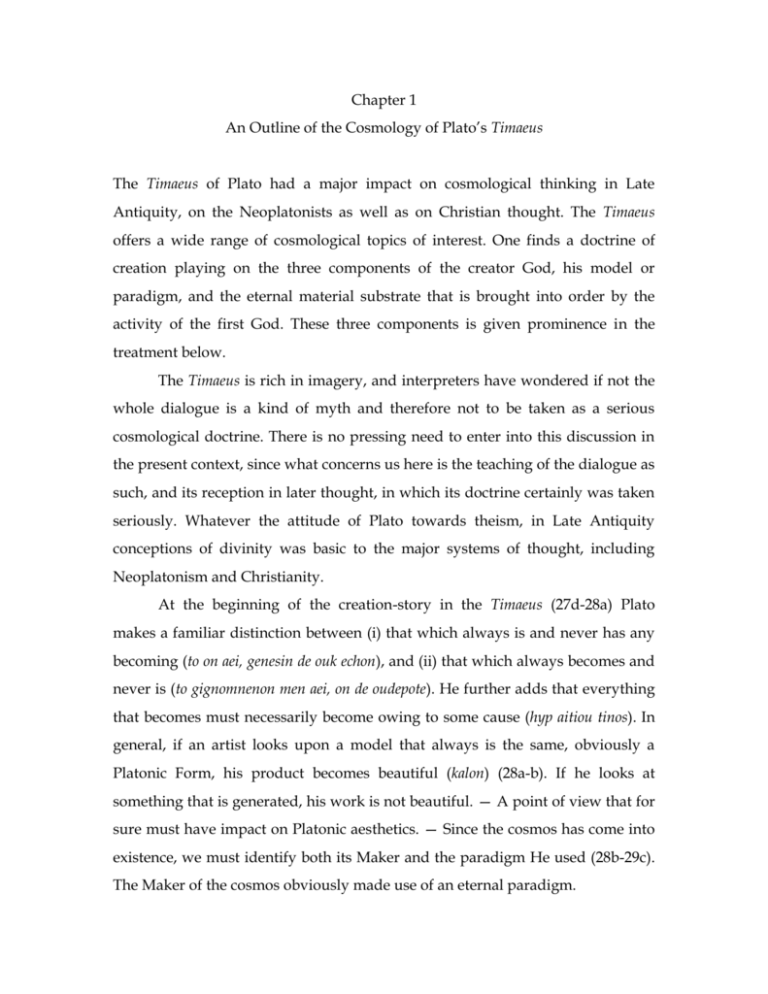
Chapter 1 An Outline of the Cosmology of Plato’s Timaeus The Timaeus of Plato had a major impact on cosmological thinking in Late Antiquity, on the Neoplatonists as well as on Christian thought. The Timaeus offers a wide range of cosmological topics of interest. One finds a doctrine of creation playing on the three components of the creator God, his model or paradigm, and the eternal material substrate that is brought into order by the activity of the first God. These three components is given prominence in the treatment below. The Timaeus is rich in imagery, and interpreters have wondered if not the whole dialogue is a kind of myth and therefore not to be taken as a serious cosmological doctrine. There is no pressing need to enter into this discussion in the present context, since what concerns us here is the teaching of the dialogue as such, and its reception in later thought, in which its doctrine certainly was taken seriously. Whatever the attitude of Plato towards theism, in Late Antiquity conceptions of divinity was basic to the major systems of thought, including Neoplatonism and Christianity. At the beginning of the creation-story in the Timaeus (27d-28a) Plato makes a familiar distinction between (i) that which always is and never has any becoming (to on aei, genesin de ouk echon), and (ii) that which always becomes and never is (to gignomnenon men aei, on de oudepote). He further adds that everything that becomes must necessarily become owing to some cause (hyp aitiou tinos). In general, if an artist looks upon a model that always is the same, obviously a Platonic Form, his product becomes beautiful (kalon) (28a-b). If he looks at something that is generated, his work is not beautiful. — A point of view that for sure must have impact on Platonic aesthetics. — Since the cosmos has come into existence, we must identify both its Maker and the paradigm He used (28b-29c). The Maker of the cosmos obviously made use of an eternal paradigm. The first important principle in the doctrine of creation in the Timaeus, is the creator-god, commonly known as the Demiurge, even though Plato’s terminology is more rich and varied. The Creator is definitely called Demiurge, but more frequently God. He is also called Father and Creator.1 As Sorabji remarks somewhere, it is tempting immediately to think of God in Christian terms, and consider God with the kind of perfections that are accorded to him in Christianity.2 We would, therefore, easily come to think of God as omniscient, omnipotent, and a Creator. However, pagan philosophers often denied attributes such as these. We shall return to this topic later. Plato’s God in the Timaeus is definitely a Creator, even if in a more restricted sense than in Christianity. When Plato’s God makes the world, he depends on a pattern, a paradigm. In this regard the divine being is surely not omnipotent, since he depends upon a paradigm not of his own making. The paradigm is external to his being. — We return to this in a little while. — The reason why God creates the world is his goodness (29d-e). He wanted all things to be as like him as possible. God wanted that all things should be good and nothing evil (30a). He then took over all that was visible, seeing that it was not at rest but in a state of discordant and disorderly motion. This brings us to the material substrate of the world. One might think that Plato’s doctrine of Forms is the most difficult part of his philosophy, his doctrine of matter, however, is not any easier to get hold of. For convenience I shall use the term matter even if it has connotations that should be kept out of the picture. Plato tells us more than once about the difficulties connected with grasping the nature of matter. It seems to me that matter is spoken of in at least three different ways in the Timaeus: (i) as the basic, pre-cosmic stuff of the cosmos and (ii) as the organized and well-structured material in the cosmos we perceive. (iii) Further, the matter of bodies in this He is called God in 30a, b, d, 31b, 32b, 34a, 55c, 69b, 73b, Demiurge in 41a, 42e, 68e, 69c, Demiurge and Father in 41a, Creator and Father in 28c. 2 Sorabji (2004), 69. 1 world may be analysed into its constituents. What concerns us most in the present context is the pre-cosmic stuff. We shall also touch upon the constituents of bodies. First we ask about pre-cosmic matter, what it is, how it may be characterized, how it functions in the making of the world. The Creator found, as just said, something visible and brought it into order from disorder (eis taxin […] ek tes ataxias, 30a). In the Philebus Plato distinguishes between four moments in the constitution of the world (23c-d), viz. the unlimited and the limit, their mixture, and the cause of their mixture: there is an unlimited element and a cause must impose Limit or ‘proportionate measure’ on it.3 The sense of unlimited (apeiron) is rather abstract. In the Philebus it does not indicate the positive quality of infinity, but rather means that there is a lack of limits or distinctions that mark one being over against another. In the Timaeus Plato says that which is to receive the resemblances of eternal things must be devoid of any particular Form (51a). Therefore, matter is the Mother and Receptacle (metera kai hypodochen) of Form. In itself it cannot be any sensible thing, like the elements: fire, air, water, or earth. Matter, so far, is that pre-cosmic condition in which there is not yet received any semblance of Form, and which therefore is invisible and completely unshaped. The metaphor of Mother is, of course, connected with the idea of fatherhood. God, Plato says, is the Father and begetter (28c) of the cosmos. The metaphor father is here understood as the primary moving power that contributes what in an essential way is formative of the new entity that is to be born, while the mother is the receiver (receptacle) of the fatherly influence. However, the material, even if without distinctive marks or definite qualities, has a contribution to make, as we shall see soon. There is another mark, quite interesting, that Plato uses to characterize the basic matter. In one passage in the Timaeus he distinguishes between three 3 Cf. Guthrie (1986), 254. moments, viz. (i) the Form, (ii) that which is made in the image of the Form, and (iii) the eternal chora (52a-b). It is the third point that is of interest to us at present. Chora may mean several things, such as the space or room in which a thing is, the proper place for something, land or countryside. I suggest space as the most adequate translation in this connection. This space is ever-existing or eternal. It does not admit of destruction and it provides a seat or a foundation (hedran) for all things that come to be. This ‘something’ is not perceptible by the senses, but may rather be grasped by some kind of reasoning that is adulterated or spurious. Even so, this space is important, since it is necessary that all things exist in some place and occupy a space. Now, if what Plato has in mind is suggested by the term space, we have to ask what this means. What kind of space does he have in mind? Is it empty space? Probably not, since he holds that primitive matter is always fleeting, in disorderly motion etc. (cf. 30a, 52c). There obviously has to be a ‘something’ to function is such ways. Maybe we could call it ‘stuff without property’,4 a state without reason (alogos, without reason or proportion) and without measure (53b). What he has in mind is a cosmological situation or condition of the most primitive kind, before any kind of definable features are present. What the Creator brings into the picture is the basic kind of order. As far as I can see Plato suggests the following sequence of development: we may keep in mind the Forms (or the paradigm) and their opposite, viz. chaotic matter, a distinction that may be formulated as the Same and the Other (cf. 35a). The Forms are always characterized by sameness, matter is always otherness, i.e. nothing remains identifiable or describable in this kind of matter. When the Same and the Other is combined, what first happens in the case of matter is that it is crystallized into geometrical bodies (cf. 53c and the following sections). There are five such bodies, and four of them are assigned to the elements: the pyramid is assigned to fire, the icosahedron to air, the octahedron to water, and the cube to 4 Which it is called by Popper, according to Guthrie (1986), 268. earth.5 In short, the basic material ‘particles’ or ‘atoms’ into which the four elements are analysable are geometrical bodies. They are too small to be seen, and are only visible in the aggregates (56b-c). Here we should make a digression and try to shed some light on a very basic Platonic issue. We saw above that God is not omnipotent rather his power or might is limited. On the one hand it is limited by the dependence on the Paradigm, but on the other had, and this is even more important and interesting, it is limited by the nature of matter. God, as we saw, wanted to make the cosmos as good as possible, which indicates that there is something that in a certain way sets a limit to what he is able to achieve, and this is because of the nature of matter. We shall look a bit closer into this. Plato says this cosmos is a mixture of Necessity and Mind (or Intellect, nous) (47e-48a): And inasmuch as Mind was controlling Necessity by persuading her to conduct to the best end the most part of the things coming into being, thus and thereby it came about, through Necessity yielding to intelligent persuasion, that this cosmos of ours was being in this wise constructed at the beginning. In this connection Plato probably has in mind Democritus’ atomism and the necessity involved in his cosmology, which is devoid of any intelligent direction by immaterial principles or teleology. Plato sees, however, that matter as such is subject to necessity, but he is convinced that even if this kind of material being is an aspect of the world, it is not the only one. There definitely is Mind in cosmic processes. Even so, Mind is not able completely to control cosmic movement. We shall return to this topic in the chapter on providence. 5 Icosahedron: a solid figure with twenty plane surfaces, octahedron: a solid figure with eight plane surfaces. The fifth is the dodecahedron: a solid figure with twelve plane surfaces. This last body was used by God for the construction of the whole cosmos. On the fifth body and the concept of ether, cf. Guthrie (1986), 284. God make the first matter crystallize into regular, but imperfect geometrical bodies. These bodies build up the four elements of fire, air, water, and earth. These elements are the building material for the bodies of beings like the ones we perceive by our senses, like the heavenly bodies, animals, and plants. In this connection we should note that material beings that inhabit air, water, and earth, are not made directly by the first Creator God, but by some lesser gods (41b-c). I am not going to describe their origin or role any closer, but only say that the first God makes the basic structure of the cosmos. He puts it in order complete with heavenly bodies encircling it and in accordance with a defined structure of time, but lower material beings he leaves to the lesser gods to make. We now have to turn to the Paradigm. The paradigm is the pattern according to which the cosmos is made. Plato calls it a Living being (zoon, 30c), and one might wonder what this could mean. Before we address this question we should note that all other living beings, individually and generically, are portions of this Living being. Some further points are made in 39e-40a: mind or intellect pervades the Forms of the Living being, and God decided that the created world should have genera of a like number as that found in the pattern. These Forms are four: one kind is the heavenly genus of gods, i.e. of the heavenly bodies, a second kind is winged beings in the air, a third kind is beings that live in the waters, and the fourth kind is terrestrial beings. What does it mean that the paradigm is a Living being? Even if the paradigm consists of Forms for genera and species, it obviously is a unity, since it is called by the unitary appellations Paradigm and Living being. Are we to suppose that this ‘entity’ is alive, living a life analogous with that of an animal? If so, why is not this being the first God? We saw above that Mind or Intellect pervades the Forms, and one might ask whose Intellect this is. There are two possibilities, (i) the Intellect of God, the Creator, or (ii) an Intellect belonging to the paradigm itself. It seems most reasonable to believe it is the Intellect of God, the Creator, that searches out the possibilities existing in the paradigm. In that case one might hold that the paradigm is a Living being because it is activated in the living thoughts of God. Obviously, this is not the same as the later Platonic doctrine that the Forms are God’s thoughts, but even so it is a slight anticipation of such a doctrine. Plato could be held to teach that the Forms are a paradigm, a Living being, to the degree they are activated in the contemplative thinking of God. Now, what about the contents of the Living being? I shall not dwell on this topic, but it seems we are to imagine some sort of system of genera and species almost like the dialectical divisions exemplified in dialogues like the Sophist. In that case we have an intelligible map of beings — a classificatory system, a taxonomy of beings — that are related to one another according to family-likeness. One last question needs to be asked about the influence of the paradigm on matter: how are the Forms related to matter? In the Timaeus there seems to be no terminology of participation, so that we need not think that material beings participate directly in the Forms. Rather it seems that entities within the cosmos get their names from the Forms and are made similar to them (52a). Matter, Plato says, which receives the likenesses or copies (aphomoiometa) of the Forms must in itself be without Form (51a, cf. 50c). This shows that the act of creation does not consist in a transportation of the Forms into matter, but in the creation of likenesses of the Forms in matter. In other words, God makes something new, something that was not there before the act of creation. There are a few more points from the cosmology of the Timaeus that should be commented on rather briefly: first, Plato’s idea that there is only one world, secondly, that the world is made such that it will last for ever, thirdly, the worldsoul, and at last, the order of the heavenly bodies. There is only one cosmos. Plato fights against the atomists who teach that there are an infinite number of worlds. As we have seen above, in the act of creation God took over all that was visible and introduced orderly motion in it (30a). There is one Creator and he makes one well-ordered world, a world that embraces all copies of all Forms in accordance with the one paradigm (cf. 30c-d). The cosmos is one, since there is one paradigm (31a). The Creator used up all portions of matter in order to create this one world (32c-33b). While the infinite number of worlds according to atomist teaching is due to material necessity, I suppose one may see in Plato’s concern the belief that according to reason the divine principles of generated being constitute a single, well ordered world. There is definitely a beginning of the world. This teaching of a beginning also concerns Plato’s doctrine of time, which we shall have to touch upon below. But there is no end to the material cosmos. It seems highly probable that Plato tries to argue this. The point is of some importance, and we shall return to it below, in connection with John Philoponus’ arguments against Proclus on the eternity of the world. In the Timaeus 32b-c Plato develops some thoughts on this. God brought into being a harmonious world, in which all the elements are made to exist in a certain proportioned balance with one another. The cosmos cannot be unbound (alyton) by anyone else but him who bound it together. In 41a-b we find the following sequence of thought. It is God who speaks: Gods of gods, those works whereof I am maker (demiourgos) and father, are indissoluble save by my will (alyta emou ge me ethelontos). For though all that is bound may be dissolved (lyton), yet to will to dissolve that which is fairly (kalos) joined together and in good case were the deed of a wicked one. Wherefore you also, seeing that you were generated, are not wholly immortal or indissoluble, yet in no wise shall you be dissolved nor incur the doom of death, seeing that in my will (tes emes bouleseos) you possess a bond greater and more sovereign than the bonds wherewith, at your birth, you were bound together. It is quite reasonable to think that what is created was originally instituted by a limited power of being, and will naturally suffer dissolution. Plato does not deny this, but on the other hand, here Plato says that only the will of God may unbind the cosmos, and if the cosmos is beautifully joined together, it must be a wicked act to dissolve it, and there is no wickedness in God. The cosmos is constructed and bound together by the will of God. God made it ‘a whole and complete body compounded of complete bodies’ (34b). As such is not only a material creation, it contains soul as well. God placed Soul in the midst of it. The Soul is older than the Body, i.e. the cosmic body. Soul is made to be the Ruler of the cosmic body (34b-c). Therefore it is a living being. Plato’s description of the making of the Soul is highly complex and quite speculative (35a-36d). We shall not enter into the details. What we shall note is that the Soul, structured from basic principles of being, somehow envelops the cosmos (36d-e), it stretches from centre to periphery, and it revolves within itself lasting throughout all time. It was impossible that the Soul joined with the cosmic body could be eternal (aionios), and therefore God made a ‘movable image of eternity’ (37d). This is Time. Time should be understood in connection with the construction of the heavens, which are made to revolve and therewith to produce days and nights, months and years (37e). Time is an image of eternity since it runs a regular sequence, revolving always in the same way as long as the world lasts. Time is here not of a linear nature, but is definitely cyclical and repetitive, and identified with the celestial motions. The fixed stars belong to the sphere at the extremity of the cosmos and are made of fire. They are divine, intelligent creatures, spherical of nature, and have two motions, viz. one on their own axis, and one daily motion of the whole sphere (40a-b). The other heavenly bodies, like the sun, moon, and planets, move in their own spheres within the sphere of the fixed stars. We shall end our description of the Platonic universe of the Timaeus here. What has been said is sufficient for our purposes, even if a lot of complex, difficult but interesting details are left out. We will return to some points in later chapters. It is, of course, not correct to say that Plato defined a world-view that became dominating for all later generations of antiquity and late antiquity. What we can say, however, is that he worked out details of a world-view that was common at the time: I suppose it was rather a common view that the earth was at the centre of heavenly movements, that somehow the cosmos had more lifeprocesses in it than we are accustomed to admit, and that the basic elements of the world was earth, water, air, and fire. The doctrine of creation, with all the factors Plato put into it, and the details of how the cosmos had been constructed, was, on the other hand, Plato’s distinctive teaching at the time, and all of these became ideas to take into consideration for coming generations of thinkers exposed to the influence of Plato’s legacy. In the next chapter we turn to an outline of Aristotelian cosmology in the Metaphysics book 12.
